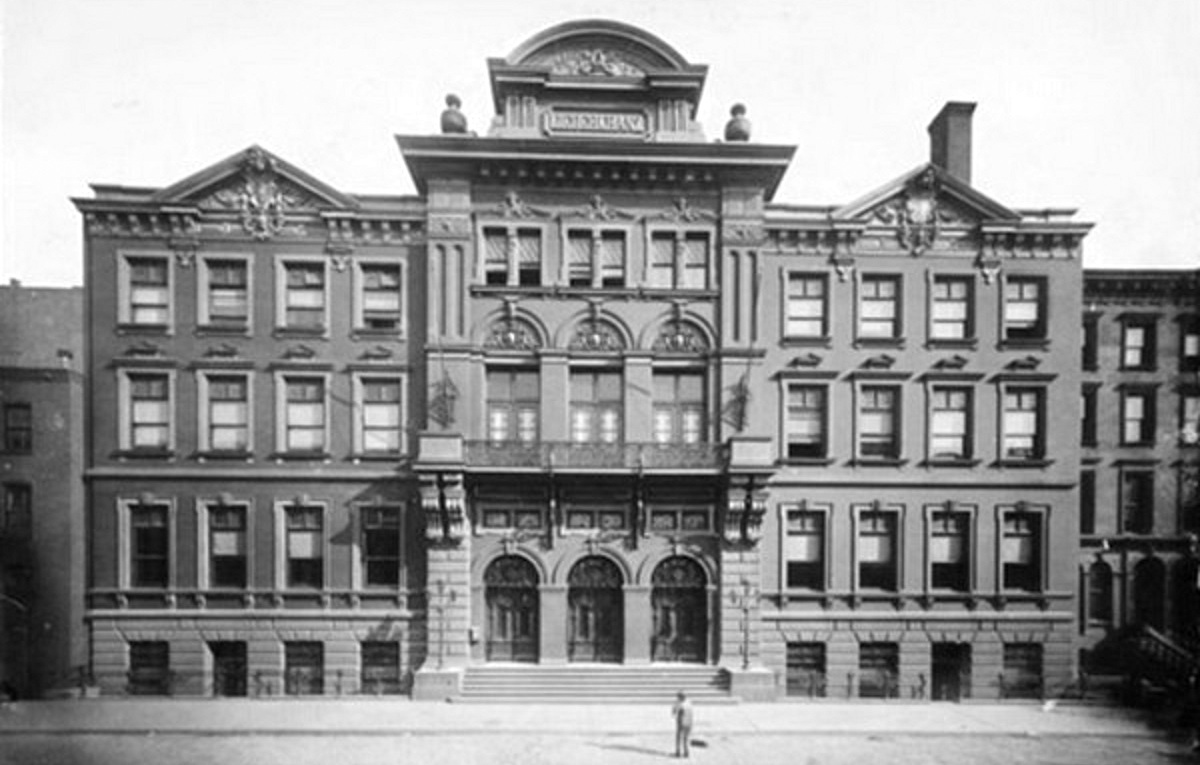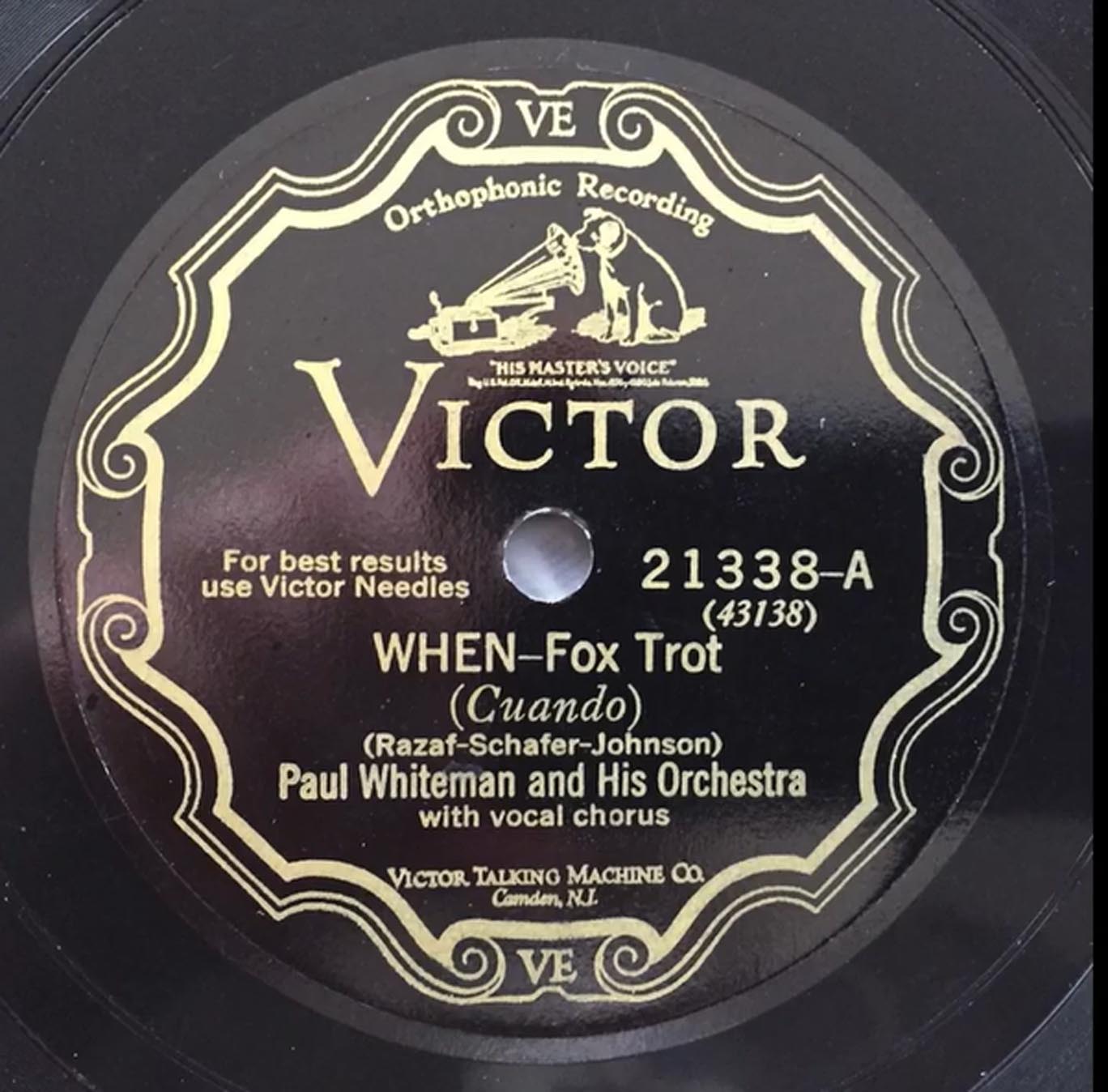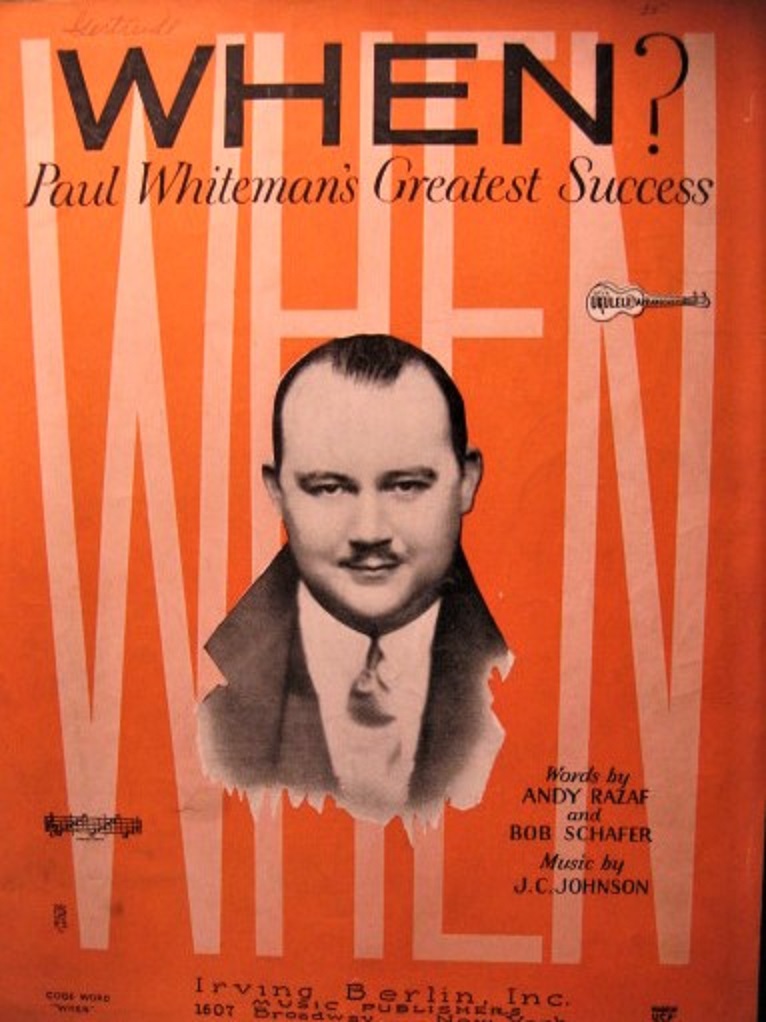Introduction
On March 12, 1928, Paul Whiteman and the musicians in his orchestra went to the Victor recording studios in Liederkranz Hall, 58th Street between Lexington and Fourth Avenue, New York, NY and recorded three numbers: “When,” “Down in Old Havana Town,” and “I’m Wingin’ Home.”

In the present article I provide information about “When,” the first number recorded in that session.
“When”—The Song
It will be seen that Andy Razaf and Bob Schafer wrote the lyrics and J. C. Johnson composed the music. When is an example of an interracial composition: two of the songwriters, Razaf and Johnson, were African American and the third, Schafer, sometimes spelled Shafer, was white.

Andy Razaf, African American poet and lyricist, was born Andriamanantena Paul Razafinkarefo on December 16, 1895, in Washington DC, and died on February 3, 1973, in North Hollywood, CA. Razaf was the son of a Madagascar nobleman and nephew of Queen Ranavalona, III of the Imerina kingdom in Madagascar. The Songwriters Hall of Fame, where Razaf was inducted in 1972, lists over 200 songs co-written by Razaf-among them “Ain’t Misbehavin,” “Black and Blue,” “Honeysuckle Rose,” “In the Mood,” “Louisiana,” and “Stompin’ at the Savoy.” Razaf co-wrote the Broadway scores for Keep Shufflin’, Hot Chocolates, and Blackbirds of 1930.
Pianist and songwriter Jay C. Johnson was born on September 14, 1896, in Chicago, IL. He collaborated with Fats Waller and Andy Razaf in writing songs. He was accompanist for Ethel Waters and several other blues singers. J. C. Johnson’s most famous composition was “The Joint is Jumpin’” later heard in the Broadway show Ain’t Misbenavin’. Johnson died on February 27, 1981, in St. Luke’s Hospital in Manhattan.
Lyricist, singer and music publisher Bob Schafer was born on July 24, 1897, in New York, NY. Beginning in 1920, he collaborated with composers (often African American) of the caliber of Duke Ellington, Fred Fisher, Johnny Burke, Spencer Williams, and Sam Wooding. He was manager of the Chicago office of Sherman Clay Music Publishers. Schaffer died in New York NY on September 28, 1943.
“When”—The Recording by Paul Whiteman’s Orchestra
According to the Victor Recording Book, the orchestra consisted of three trumpets, two trombones, six saxes, banjo, string bass, tuba, piano and trapman. The vocalists were Fulton, Gaylord, Young, Rinker, and Barris.
According to the Discography of Historical of American Recordings, the vocalists were Bing Crosby, Al Rinker, Austin “Skin” Young, Charles Gaylord, Jack Fulton. The inclusion of Crosby is incorrect. The fifth vocalist was Harry Barris.

Whiteman’s Recording of “When,” Discographical Data. From Rust [1], Rayno [2] and Sudhalter and Evans [3]:
 Paul Whiteman and His Orchestra. Liederkranz Hall, New York, NY. March 12, 1928.
Paul Whiteman and His Orchestra. Liederkranz Hall, New York, NY. March 12, 1928.
Charles Margulis, Eddie Pinder (tp); Bix Beiderbecke (c); Boyce Cullen, Bill Rank (tb); Frank Trumbauer, Chester Hazlett, Irving Friedman, Charles Strickfaden, Rube Crozier, Roy Maier (reeds); Roy Bargy (p); Mike Pingitore (bj); Mike Trafficante (sb); Min Leibrook (tu); Hal McDonald (dm) ;++
Jack Fulton, Charles Gaylord, Austin Young, Al Rinker, Harry Barris (voc).
Recording Director: Paul Whiteman; Assistant Director and Arranger: Thomas Satterfield.
43138-1 Destroyed.
43138-2 Master Victor 21338, Released May 18, 1928. HMV B-5493. Gramophone France K-5606.
Gramophone (Czechoslovakia) AM-1192.
43138-2 Master Victor 25367. From dub made 7/13/1936
43138-3 Hold indefinitely. Master Victor 21338,
I nterestingly, Victor 21338 specifies “with vocal chorus.” Victor 25367 does not, but includes the name of the arranger and of three of the soloists featured in the recording: Bix, Trumbauer, and Friedman. Furthermore, note that the sheet music cover includes a question mark after the word “When,” but the copyright and the record labels do not.
nterestingly, Victor 21338 specifies “with vocal chorus.” Victor 25367 does not, but includes the name of the arranger and of three of the soloists featured in the recording: Bix, Trumbauer, and Friedman. Furthermore, note that the sheet music cover includes a question mark after the word “When,” but the copyright and the record labels do not.
The legendary French Composer Maurice Ravel attended the March 12, 1928, recording session at Liederkranz Hall. Pianist Roy Bargy recalled some of the circumstances. [3] “We played Ferde Grofé’s Metropolis and the Suite Of Serenades by Victor Herbert for him. He was politely interested but not overly enthusiastic about either composition but seemed to appreciate the musicianship of the players.”
The structure of the arrangement. [2] [4]:
When ABAC-32
Intro 6 Bix & band; 2 trombone, Bill Rank.
(1) ½ 30 trumpet & band.
Verse 8 clarinet, Izzy Friedman; 12 saxophone, Frank Trumbauer.
(2) ½ 30 choir, the “sweet trio” Jack Fulton, Charles Gaylord and Austin Young.
(3) 8 scat vocal, Harry Barris with the sweet trio plus Al Rinker; 6 Bix; 10 scat vocal, Harry Barris with the sweet trio plus Al Rinker; 6 Bix; 2 drum & band.
(4) 32 band.
A Selection of Later Recordings of “When”
Whiteman’s orchestra was the first to record “When.” A little over three months later, on June 21, 1928, in Indianapolis, IN, Charlie Davis (composer of “Copenhagen”) and His Orchestra recorded “When.” The recording was issued on Vocalion 157001 and included Dick Powell on banjo.
It did not take long for the song to cross the Atlantic.
In July-August 1928, Billy Bartholomew and His Delphians recorded “When” in Berlin, Germany with Al Bowlly on vocal. The recording was issued on Grammophon 21654.
There was one recording of “When” in the 1930s. Vocalist and pianist Cleo Brown accompanied by Bobby Sherwood (g), Manny Stein (b), and Vic Berton (d) recorded “When” in Los Angeles, CA on November 20, 1935. It was issued on Decca 718.
Tommy Dorsey and his orchestra recorded “When” in New York, NY, on September 6, 1949 (rejected) and again on January 5, 1950, issued on Victor 20-3910. Dorsey’s orchestra played When in his “Navy Swings” radio programs of the 1950s.
Jack Teagarden and His Sextet played “When” at their live “Roundtable Club” appearance in New York, NY, on July 1, 1959.
Several Jazz Repertory orchestras recorded “When.” Among them:
– The New Paul Whiteman Orchestra with Dick Sudhalter (tp) Keith Nichols (tb, John R.T. Davies (reeds) and others in London, England, on October 9, 1974, Monmouth Evergreen MES7074
– Randy Sandke’s New Yorkers in New York, NY, December 4-6, 1990, Jazzology JCD-211.
– John Howard’s San Francisco Starlight Orchestra in Berkeley, CA, December 19, 1992, Stomp Off CD1271.
– Randy Sandke’s The New York Allstars in Hamburg, Germany, May 1, 1993, Nagel-Heyer (G)CD002.
– Lino Patruno & The Red Pellini Gang in Castelnuovo, Italy, November 7, 1998, JSCD-02 [CD].
References
[1] Brian Rust, Jazz and Ragtime Records 1897–1942 (6th revised and expanded ed.). Mainspring Press, 2002, Denver CO.
[2] Don Rayno, Paul Whiteman: Pioneer of American Music (Volume 1: 1890-1930), Studies in Jazz, No. 43, The Scarecrow Press, Inc., 2003, Lanham, MD.
[3] Richard M. Sudhalter and Philip R. Evans with William Dean-Myatt, Bix: Man and Legend, Arlington House, 1974, New York, NY.
[4] Vittorio Castelli, Evert (Ted) Kaleveld and Liborio Pusateri, The Bix Bands, Disco-biography, 1972, Raretone, Milan, Italy.
[5] Tom Lord, The Jazz Discography Online, www.lordisco.com
Dr. Albert Haim is Professor Emeritus of Chemistry at SUNY Stonybrook and a renowned authority on the recordings of Bix Beiderbecke.
Dr. Albert Haim is Professor Emeritus of Chemistry at SUNY Stonybrook and a renowned authority on the recordings of Bix Beiderbecke






















